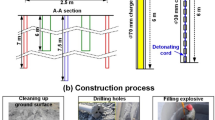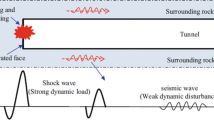Abstract
Based on the new viewpoint of interaction mechanics for solid and gas, gas leakage in parallel deformable coal seams can be understood. That is, under the action of varied geophysical fields, the methane gas flow in a double deformable coal seam can be essentially considered to be compressible with time-dependent and mixed permeation and diffusion through a pore-cleat deformable, heterogeneous and anisotropic medium. From this new viewpoint, coupled mathematical models for coal seam deformation and gas leak flow in parallel coal seams were formulated and the numerical simulations for slow gas emission from the parallel coal seams are presented. It is found that coupled models might be close to reality. Meanwhile, a coupled model for solid deformation and gas leak flow can be applied to the problems of gas leak flow including mining engineering, gas drainage engineering and mining safety engineering in particular the prediction of the safe range using protective layer mining where coal and gas outbursts can efficiently be prevented.
Similar content being viewed by others
References
Bear, J. (1972) Dynamics of Fluids in Porous Media, American Elsevier Publishing Co. Inc. New York.
Bear, J. and Bachmat, Y. (1991) Introduction to Modeling of Transport Phenomena in Porous Media, Kluwer Academic Publisher, Netherlands.
Biot, M. A. (1941) General theory of three-dimensional consolidations, J. Appl. Phys., 12, 155–164.
Jaeger, J. C. and Cook, N. G. W. (1979) Fundamentals of Rock Mechanics, Third Edition, Chapman and Hall, London.
Peide Sun. (1990) A new method for calculating the gas permeability of a coal seam, Int. J. Rock Mech. Min. Sci. & Geomech. Abstr., 27, 325–327.
Peide Sun. (1991) Study of dynamic models for coal gas dynamics (Part 1), Mining Science & Technology, 12, 17–26.
Peide Sun. (1998) A study on the interaction mechanics for coal seam deformation and gas leak flow and its numerical simulations, University of Chongqing, Ph.D. thesis, (in Chinese with English abstract).
Peide Sun. (2000) Interaction modeling for mining safety range and numerical simulations, Journal of Coal Science & Engineering, 6, 41–46.
Peide Sun. (2001) Testing study on coal specimen permeability during solid deformation process, Chinese Journal of Rock Mechanics & Engineering, 20, 1801–1804 (in Chinese with English abstract).
Peide Sun. (2002a) Sun Model and its Applications, Zhejiang University Press, Hangzhou (in Chinese with English summary).
Peide Sun. (2002b) SIP analysis on coupled models for coal seam deformation and gas leakage flow, Journal of China Coal Society, 27, 276–280 (in Chinese with English abstract).
Peide Sun and Xuefu Xian. (1998) Solid-gas coupled analysis for safety range of upper protective layer mining, Chinese Journal of Rock Mechanics & Engineering, 17, 932–936 (in Chinese with English abstract).
Peide Sun and Xuefu Xian. (1999) A study on coupled models for coal seam deformation, gas leak flow and its applications, Journal of China Coal Society, 24, 60–64 (in Chinese with English abstract).
Peide Sun, Xuefu Xian and Daijun Zhang. (1996) Dynamics of gas seepage and its applications, Journal of Coal Science & Engineering, 2, 67–71.
Peide Sun, Xuefu Xian and Yaoming Qian. (1999) Experimental research on the rule of effective stress on coal mass, Mining Safety & Environmental Protection, 20, 16–18 (in Chinese with English abstract).
Saghafi, A., Jeger, C. Tauziede, C. and Williams, R. J. (1987) A new computer simulation of in seam gas flow and its application to gas emission prediction and gas drainage, In: Proceedings of the 22nd International Conference of Safety in Mines Research Institutes. Beijing, China, Nov. 1987 (edited by Guoquan Dai). China Coal Industry Publishing House, Beijing, pp. 147–160.
Sommerton, W. J., Soylemezoglu, I. M. and Dudley, R. C. (1975) Effect of stress on permeability of coal, Int. J. Rock Mech. Min. Sci. & Geomech. Abstr., 12, 129–145.
Stone, H. L. (1986) Iteration solution of implicit approximations of multi-dimensional partial differential equations, J. Soc. Ind. Appl. Math., 5, 530–558.
Terzaghi, K. (1943) Theoretical Soil Mechanics, John Wiley and Sons, New York.
Yangsheng Zhao. (1994a) Coupled mathematical models on coal mass-methane and its numerical method, Chinese Journal of Rock Mechanics & Engineering, 13, 229–239 (in Chinese with English abstract).
Yangsheng Zhao. (1994b) Rock Fluid Mechanics in Mine, China Coal Industry Publishing House, Beijing, (in Chinese).
Yangsheng Zhao, Zhongming Jin and Jun Sun. (1994) Mathematical model for coupled solid deformation and methane flow in coal seams, Appl. Math. Modelling, 18, 328–333.
Yuqun Xue and Chunhong Xie. (1980) Numerical Methods in Hydrogeology, China Coal Industry Publishing House, Beijing (in Chinese).
Author information
Authors and Affiliations
Rights and permissions
About this article
Cite this article
Sun> , P. Numerical simulations for coupled rock deformation and gas leak flow in parallel coal seams. Geotechnical and Geological Engineering 22, 1–17 (2004). https://doi.org/10.1023/B:GEGE.0000013995.00696.8c
Issue Date:
DOI: https://doi.org/10.1023/B:GEGE.0000013995.00696.8c




